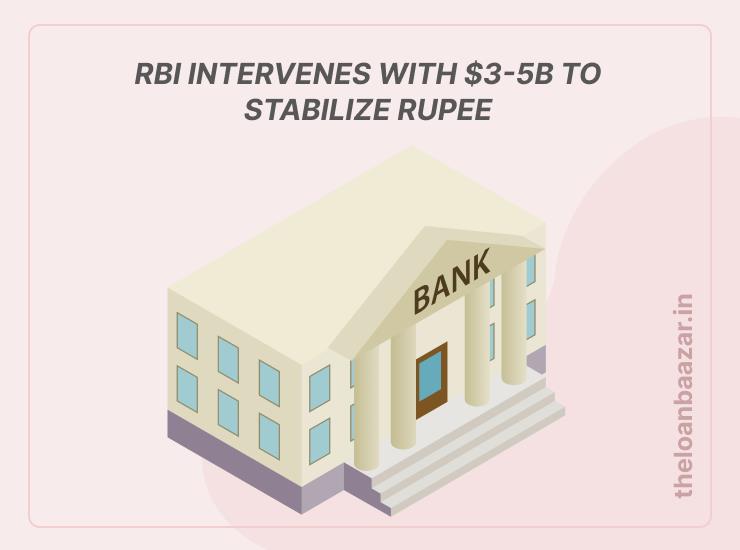RBI Intervenes with $3–5 Billion to Stabilize the Rupee
In a powerful move to defend the Indian rupee, the Reserve Bank of India (RBI) reportedly sold between $3 billion and $5 billion in the foreign exchange market. This strategic intervention comes amid sustained pressure on the rupee, which had been depreciating due to global economic uncertainty and rising crude oil prices.
According to Reuters, the RBI acted in both spot and non-deliverable forward (NDF) markets, helping the rupee make its largest single-day gain in months — strengthening to ₹87.70 against the US dollar.
Why the Rupee Was Under Pressure
The Indian rupee has been facing depreciation pressures for several reasons:
-
Strong US Dollar: The US dollar has remained firm as investors seek safe havens amid global tensions.
-
High Crude Prices: India imports over 80% of its oil, and rising global prices directly affect the rupee.
-
Capital Outflows: Foreign Institutional Investors (FIIs) were withdrawing funds from emerging markets.
-
Trade Deficit: India’s widening trade deficit has also put downward pressure on the currency.
These combined forces pushed the RBI to step in and defend the rupee to maintain financial stability.
How RBI’s Intervention Works
When the rupee weakens sharply, the RBI sells US dollars from its forex reserves to supply dollars in the market. This increases the availability of dollars, reducing demand, and helps stabilize the rupee.
The RBI can intervene in two ways:
-
Spot Market: Immediate sale or purchase of foreign currency.
-
Non-Deliverable Forward (NDF) Market: Futures-based currency transactions that influence offshore rupee trading.
This dual strategy ensures that both domestic and offshore markets see reduced volatility.
India’s Forex Reserves and Stability
India’s foreign exchange reserves currently stand near $635 billion, giving the RBI a comfortable buffer to manage currency fluctuations.
Despite the $3–5 billion sale, analysts believe India still maintains strong reserve adequacy. A controlled, well-timed intervention like this prevents panic and assures markets that the central bank is actively managing volatility.
The Immediate Market Impact
Following RBI’s intervention, the rupee gained over 40 paise intraday, one of its sharpest recoveries in recent times.
The USD-INR rate improved from ₹88.10 to ₹87.70, while domestic equities also turned positive as sentiment strengthened.
Bond markets reacted mildly, as traders anticipate that the central bank might maintain a balanced approach — defending the currency while keeping liquidity comfortable.
Global Context: Why Other Central Banks Intervene Too
India isn’t alone in using foreign exchange interventions. Central banks like the Bank of Japan, People’s Bank of China, and South Korea’s Bank of Korea regularly step in to prevent their currencies from overshooting during volatile times.
These interventions ensure that currency depreciation doesn’t spiral into imported inflation, especially in oil-dependent economies like India.
The Economic Implications
1. For Importers:
A stronger rupee means lower import costs — especially beneficial for sectors like oil, electronics, and pharmaceuticals.
2. For Exporters:
A slightly stronger rupee may reduce export competitiveness, but the stability ensures long-term planning for exporters.
3. For Common Consumers:
If the rupee holds steady, it can help control inflation, particularly in fuel and food prices.
4. For Investors:
Stable currency movement tends to attract foreign investments, as it reduces exchange-rate risk.
The Bigger Picture: Confidence in India’s Economy
The intervention also signals confidence in India’s macroeconomic fundamentals. With inflation moderating, growth strong, and reserves healthy, the RBI has space to manage volatility without fear of depleting its reserves.
The IMF recently upgraded India’s GDP growth outlook to 6.6%, reinforcing optimism that India remains the fastest-growing large economy globally.
RBI’s Strategy Going Forward
Market participants believe the RBI will continue using a “leaning against the wind” approach — stepping in to smooth volatility without trying to fix a specific rate.
This flexible stance ensures that India’s currency remains market-driven yet stable, striking the perfect balance between competitiveness and confidence.
FAQs
1. Why did the RBI sell dollars?
To reduce volatility in the rupee and prevent excessive depreciation caused by global and domestic factors.
2. Will the RBI’s move make imports cheaper?
Yes, a stronger rupee reduces import costs, particularly for crude oil, electronics, and machinery.
3. Does this affect inflation?
Yes, stabilizing the rupee helps prevent inflation from rising due to expensive imports.
4. How does this impact forex reserves?
While reserves dip slightly due to sales, India’s reserves remain healthy and sufficient for continued intervention if needed.
5. Is this a permanent solution?
No — it’s a short-term measure. Sustainable stability depends on trade balance, capital flows, and fiscal discipline.
The RBI’s $5 billion lifeline to the rupee sends a strong message — India’s central bank will not allow panic in currency markets. With robust reserves and steady growth, India remains well-positioned to manage global headwinds. For investors, businesses, and consumers alike, this intervention represents stability and confidence in India’s financial system.











